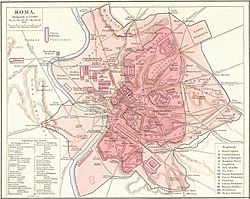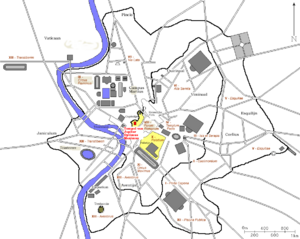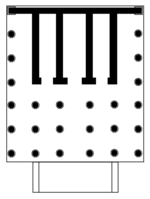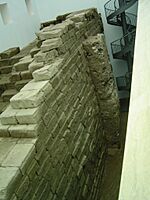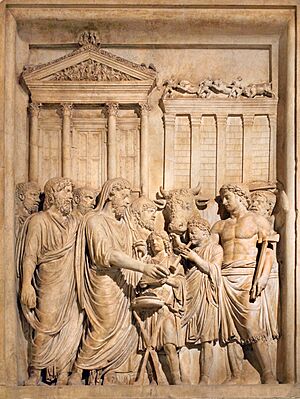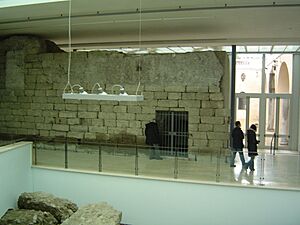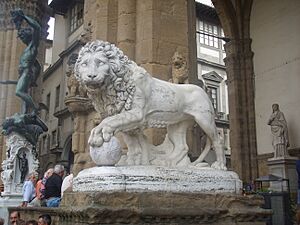Temple of Jupiter Optimus Maximus facts for kids
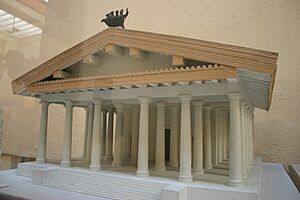
Speculative model of the first Temple of Jupiter Optimus Maximus, 509 BC
|
|
| Coordinates | 41°53′32″N 12°28′54″E / 41.89222°N 12.48167°E |
|---|---|
The Temple of Jupiter Optimus Maximus, also known as the Temple of Jupiter Capitolinus, was the most important temple in Ancient Rome. It stood on the Capitoline Hill, a famous spot in the city. This temple was surrounded by an area called the Area Capitolina, which had many smaller shrines, altars, statues, and trophies from victories.
The first temple was built a very long time ago, around 509 BC. It was one of the oldest large temples in Rome. Its design was similar to Etruscan architecture, and skilled workers from Etruria helped build and decorate it. This first temple was made of wood and was sadly destroyed by a fire in 83 BC. After that, new temples were built on the same spot, using the same foundations. These later temples were more like Greek and then Roman temple styles, but they kept some of the original Etruscan ideas.
The first temple was huge for its time, much bigger than other Roman temples for many centuries. Its exact size is still debated by experts, but it was definitely impressive. This temple greatly influenced how other early Roman temples were built. Over time, the temple was rebuilt three more times after fires, with each new version becoming grander. The last temple stood for over 300 years until the Roman Empire declined. Today, only parts of its foundations and base remain.
Contents
History of the Temple
Building the First Temple
Much of what we know about the first Temple of Jupiter comes from old Roman stories. A Roman king named Lucius Tarquinius Priscus promised to build this temple during a battle. He started preparing the land on the Capitoline Hill. Later, another king, Lucius Tarquinius Superbus, finished most of the temple's main structure.
Before the temple was built, there were shrines to other gods on the site. Roman priests, called augurs, performed rituals to ask these gods for permission to move their shrines. Only two gods, Terminus (god of boundaries) and Juventas (goddess of youth), seemed to refuse to move. So, their shrines were included in the new temple. This was seen as a good sign for Rome's future. Another good sign happened when workers found a human head while digging the foundations. Priests said this meant Rome would become the head of a great empire.
The temple was officially opened on September 13, 509 BC, the year the Roman Republic began. This was a very important event. The new leaders of Rome, called consuls, were in charge of the dedication.
Design of the First Temple
The first temple was very large, possibly around 60 by 60 meters. It was considered the most important religious building in all of Rome. Inside, it had three separate rooms, called cellae, for three main gods: Juno Regina, Minerva, and Jupiter Optimus Maximus. Jupiter's room was in the middle.
The temple was decorated with many clay sculptures. The most famous was a statue of Jupiter riding a quadriga (a chariot pulled by four horses) on the roof. The main statue of Jupiter inside the temple was also made by a famous Etruscan artist named Vulca of Veii. Jupiter was shown holding a thunderbolt and wearing special clothes that later became the standard outfit for victorious Roman generals.
Archaeologists found parts of the original temple decorations in 2014. These findings helped them understand how the temple really looked. The wooden parts of the roof were covered with beautifully painted clay decorations. This temple's design became a model for many other temples in Italy for centuries. Over time, parts of the temple were updated, like adding mosaic floors and gilding the ceiling. Many statues and trophies were also added by successful generals.
The first temple burned down in 83 BC during a civil war. Important books called the Sibylline Books, which contained prophecies and advice for the Roman state, were also lost in this fire.
-
Possible plan of the first temple
The Second Temple
After the fire, a new temple was built on the same foundations. Some huge columns from a temple in Athens were brought to Rome and might have been used here. The new temple was dedicated in 69 BC. It used more expensive materials for its upper parts. Around 65 AD, new statues of the gods were completed. The statue of Jupiter was made of gold and ivory, showing him seated with a thunderbolt and scepter.
This second temple also burned down during a battle on the hill in 69 AD.
The Third Temple
The new emperor, Vespasian, quickly rebuilt the temple on the same foundations. This version was even taller and more decorated. It had fancy Corinthian order columns and statues, including a quadriga on the roof. The third temple was dedicated in 75 AD. However, it only lasted five years before burning down again in 80 AD during the reign of Titus.
The Fourth Temple
Emperor Domitian immediately started rebuilding the temple for the fourth time, again on the same foundations. This was the most lavish version yet. It's said that Domitian used a huge amount of gold just to gild the bronze roof tiles. The front of the temple was covered with elaborate sculpture. In the center, Jupiter was seated between Juno and Minerva. Below them was an eagle.
This fourth temple was finished in 82 AD. It stood strong for over 300 years.
End of the Temple's Use
The Temple of Jupiter was used until all non-Christian temples were closed by Emperor Theodosius I in 392 AD. In the 4th century, people still admired it greatly. Over the next centuries, parts of the temple were damaged and its valuable materials were taken. For example, the Vandals took half of the gilded bronze tiles during the sack of Rome in 455. Even so, in the early 6th century, it was still described as one of the wonders of the world. By the 16th century, most of the remaining ruins were destroyed to build a new palace.
What Remains Today
Today, you can see parts of the temple's base and foundations. They are located behind the Palazzo dei Conservatori and inside the Musei Capitolini in Rome. A small part of the eastern corner is also visible on a street called via del Tempio di Giove.
Interestingly, one of the famous Medici lions statues, made in the late 16th century, was carved from a stone capital that came from the Temple of Jupiter Optimus Maximus.
The Area Capitolina
The Area Capitolina was the sacred area around the Temple of Jupiter on the Capitoline Hill. It was enclosed by walls that followed the shape of the hillside. This area was expanded in 388 BC to about 3,000 square meters. The main entrance was on the southeast side, and there was also a secondary gate. These gates were closed at night.
The famous sacred geese of Juno, who supposedly warned Rome during a siege, were kept in this area. During the Roman Empire, dogs also guarded the precinct. The Area Capitolina contained many smaller shrines, altars, statues, and victory trophies. Some Roman assemblies also met there. In later times, it became a market for luxury goods.
| Capitoline Hill plan |
|---|
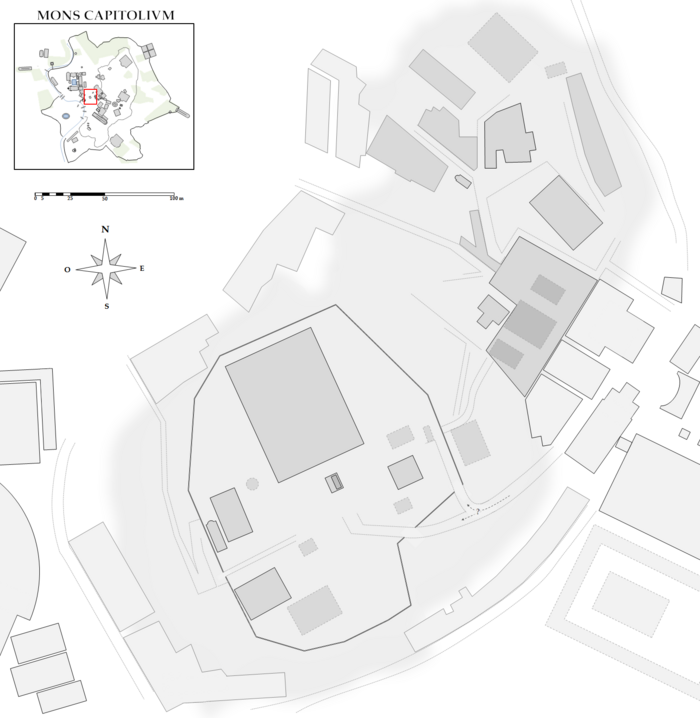
Area
Capitolina Arx
Forum
Romanum Fori
Imperiali Velabrum
Temple of
Jupiter Optimus Maximus Tabularium
Temple of
Juno Moneta Theatre of
Marcellus Forum
Holitorium Temple of
Bellona Temple of
Jupiter Feretrius Temple of
Veiovis Auguraculum
Iseum
Temple of
Jupiter Custos (?) Temple of
Concord (?) Temple of
Jupiter Conservator Altar
Aedes
Tensarum Temple of
Jupiter Tonans Clivus
Capitolinus Centus
Gradus Porta Pandana
Temple of
Hope (Spes) Temple of
Piety (Pietas) Temple of
Juno Sospita Temple
of Divus Augustus Asylum
Inter duos lucos
Vicus
Jugarius Campus
Martius Portico
Dii Consentes Temple of
Vespasian and Titus Temple
of Concord Tullianum
Clivus
Argentarius Temple of
Venus Erycina Temple of
Mens (?) Temple of
Fides (?) Temple
of Ops(?) Arch
of Scipio Temple of
Saturn Basilica
Julia |
See also
- List of Ancient Roman temples


